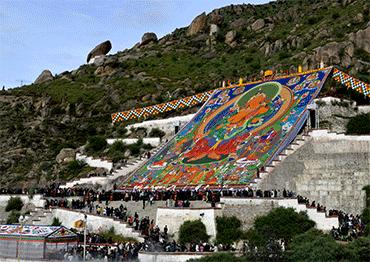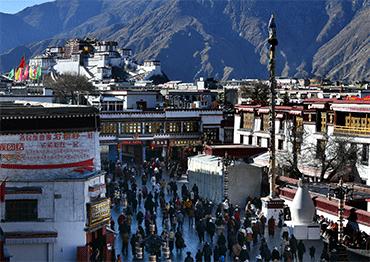Many of the lesser-known religious sites in Lhasa are far smaller and humbler than their famous neighbors and are all the more meaningful for it. They offer an intimate window into the daily rhythms of Tibetan spiritual life, where incense wafts through shaded courtyards, and prayer wheels spin with quiet devotion. One of my favorite discoveries was Ani Tsankhung Nunnery, hidden away in the narrow alleys of central Lhasa. It does not demand an entire afternoon, but I found myself lingering far longer than expected. There was something deeply calming about sitting in the modest courtyard, simply observing the lives of the shaven-headed nuns as they moved purposefully through their day, sweeping, chanting, praying or tending the small kitchen that serves up humble vegetarian cuisine. In contrast to the crowds at Jokhang Temple or Sera Monastery, I found myself the only visitor inside the nunnery other than my guide. None of the residents fussed over my presence, rather they greeted me with politeness and genuine warmth and I was left to soak in the serenity.
Many of Lhasa’s smaller sites ask only a nominal fee for entry, and include basic facilities that visitors are welcome to use, such as public toilets and canteens. Once such destination is Ramoche Monastery, which felt like stepping into a living relic of the past. Dating back to the 7th century, it is one of Lhasa’s most atmospheric sites, yet sees remarkably few visitors. Nestled quietly behind the more famous landmarks, its halls are filled with exquisite Buddhist art, from delicate thangkas to solemn statues that radiate centuries of silent devotion. In the cool shadows of its corridors, I sensed something unfiltered and enduring, pockets of authentic Tibetan life, still beating gently beneath the city’s ever-modernizing surface.
A short walk away, just off Beijing Middle Road, lies Kundeling Temple. Modest and a little rough around the edges, this temple captured my heart. Two restored chapels are open to the public, and I was fortunate to visit on a cold but sunny morning when the light streamed through the lattice windows. I learned that the monastic community consisted of approximately 42 monks, 10 of them barely out of their teens. These young monks take on much of the daily labor, from sweeping the courtyards to cooking simple meals and tending to minor repairs. There are no smartphones or distractions here. Life is quiet, austere and deeply disciplined. It was humbling to witness their quiet dedication.
Perhaps the grandest surprise of all was the Norbulingka. Despite being one of Lhasa’s most historically significant sites, the summer residence of the Dalai Lamas since 1755 and now a UNESCO World Heritage Site, few foreign tourists seem to make it here. Spanning over 36 hectares, the gardens are lush and serene, with shaded pathways, still ponds and brightly painted pavilions. During the warmer months, the grounds come alive with music, dancing and festivities. For those with an interest in Xizang’s more formal historical narratives, Lhasa Museum is worth a visit. Though still under expansion, this official government museum offers an informative look at Xizang’s complex past. Plans are underway to significantly enlarge its galleries, promising even richer displays in the future.

 Old Version
Old Version
